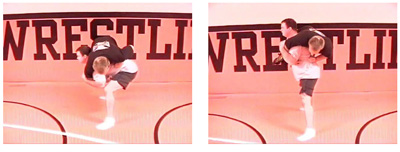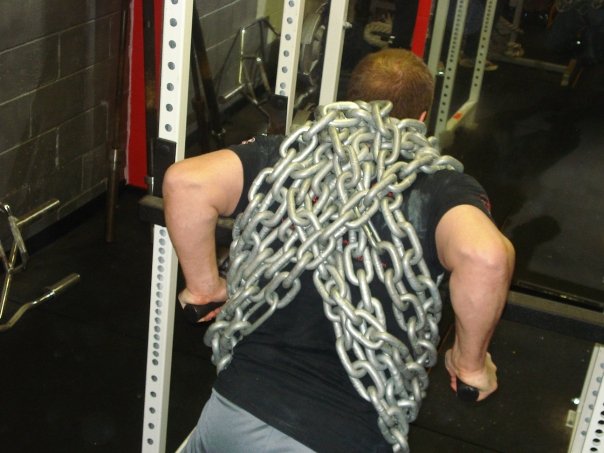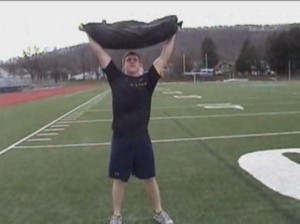Odd Object Training
Preface
Odd object training has become popular in the last several years as a means for developing general strength qualities for fitness enthusiasts and athletes.
Definition on an Odd Object
An odd object can be defined as a non-rigid implement who’s center of mass is not fixed and is ever changing. It acts non-linear in a system and creates tension that does not act opposite or parallel to an anatomical movement pattern (horizontal push/pull, vertical push/pull, rotational, hip dominant, quad dominant), but rather chaotically in opposition to ANY fixed movement.
Adaptation to Odd Object Training
When engaging in conventional strength training means, such as a squat, deadlift or bench press, the movement pattern is fixed and the load acts in this plane. Odd objects provide a loading that causes shifts and adjustments throughout the movement pattern providing a more comprehensive adaptation.
For example, take a sandbag press. If the sandbag is 100 lbs and the lifter presses it overhead, each arm does not have to overcome 5o lbs each – (like a conventional barbell military press whose COM (or COG) is fixed). Instead, the sand in the sandbag shifts as it is pressed and at any point in time, each arm has varying loads to press. At point 1, the left arm might be pressing 30 lbs and the right arm could be pressing 70 lbs. At point 2, the left arm might be pressing 40 lbs and the right arm could be pressing 60 lbs. And so on…
Some term this “real world training”. I would lean toward this term as a more general description but it is not absolute. Others term this type of training as “functional”, but this is even further from the truth. When trainers talk of functional training, their application is always toward athletics. A means cannot be termed as “functional” unless you are actually playing the sport or have satisfied all of Verkhoshansky’s Principles of Dynamic Correspondence.
Benefits of Odd Object Training – (see the Chaos Manual)
- portable
- rapid adaptation
- versatile
- increased work capacity (GPP)
- bridging the gap from GPP to SPP
Odd Objects 101
Sandbags

What They and How are They Used:
Sandbags fit all the criteria of being an odd object. There are several ways to prepare a sandbag to use in a gym or for an outside training session.
For years we have used an army duffle bag that we purchased on ebay. It has held up very well. Now you don’t want to jump dump the sand into the bag directly. You need to put some kind of liner to put the sand in prior to putting it into the bag.
To line a sandbag you can use:
- contractor bags (30 gallon, thick black plastic bags)
- nylon woven bags (used to haul feed for animals on farms)
- other nylon duffle bags
- prefab liners made by sandbag manufacturers specifically to load sandbags
You can fill a sandbag with:
- sand
- pea gravel
- dirt
I prefer pea gravel because it is cleaner and can be easily used within a commercial gym setting.
Typically, the “liners” that you put into the sandbag are broken into smaller increments. For example, if you are making a 100 lb sandbag, you would fill it with 4 x 25 lb fillers.
What has worked for me is to take the 25lb bags of play sand from Walmart and keep them in their plastic bags. Take the duct tape and duct tape around the entire plastic bag. Now you have 4 x 25 lb duct tape packages that you can incrementally fill your sandbag with.
Now, when you use the liners above to contain the sand within the sandbag, they will spring “leaks”. So it is a good idea to use duct tape to seal these cracks.

Every exercise you can think of, you can do with a sandbag, so get creative. And because you will only be utilizing one implement, you can easily transition from one exercise to the other for a great strength training circuit.
6 Week Kettlebell / Sandbag Workout
Sandbag Press

Sandbag Zercher Lunge

Quick Sandbag Workout
1) Sandbag Clean and Press, 3×6
2) Sandbag Clean and Squat, 4×8
3) Sandbag Floor Press, 4×8
4) Sandbag Good Morning, 3×12
2) Sandbag Clean and Squat, 4×8
3) Sandbag Floor Press, 4×8
4) Sandbag Good Morning, 3×12
Water / Sand Kegs

What They and How are They Used:
Water filled odd objects are among the most unstable implements you can use. Because of the shifting of the water and ever changing redistribution of mass, the lifter must constantly and powerfully change their tension to overcome and impart movement into the object.
A typically half keg when filled with water will weigh any where from 145-155lbs. So you can interpolate then that the weight of a half filled keg would be around 75-85lbs.
There are two types of kegs:
- old barrel style with no handles
- sanke keg with handles
How to fill kegs:
Old Barrel Keg – drill out the old cork plug in the side of the barrel and fill accordingly. Then replace with a rubber stopper from McMaster-Carr.
Sanke Keg - can be disassembled by using this technique
Kegs can be filled with:
- water
- sand
- dirt
- pea gravel
Most Popular Keg Exercises
- shoulder lunges
- zercher lunges
- clean & press
- bearhug good mornings
- military press
- pull throughs
- shoulder squats
- zercher squats
- loading onto platform
Keg Clean & Press


Keg Bearhug Good Morning


Water Filled Swiss Ball

What They and How are They Used:
A anti-burst swiss ball is filled with water and resealed. Similar to a water filled keg, water filled swiss balls have a more intense grip component to all their lifts. The lifter must aggressively grab the swiss ball to maintain control of the lift.
The swiss ball is typically filled between 50 and 75% capacity.
Typical movements executed with a water filled swiss ball:
- bear hug squats
- bear hug lunges
- bear hug good mornings
- curl to press
Photo courtesy of Ross Enamait:

Slosh Pipe
What They and How are They Used:
A sloshpipe is a device developed by Dan John. A 10′ length of 4″ PVC pipe is filled to approximately 50-75% capacity and capped on the ends with end caps. Glue or duct tape is added to ensure there is minimal leakage.
As the sloshpipe is lifted the water “sloshes” from side to side and the lifter will have to adjust and counteract these shifts.
Typical movements done with a slosh pipe:
- overhead walks
- overhead pressing
- zercher squats
- zercher walks
Elastic Bands

What They and How are They Used:
Heavy elastic bands can be used as an odd object. They can provide external resistance that is in opposite to or counteractive to the plane of movement – see Chaos Manual.
Elastic bands can be used:
- to hang kettlebells from a barbell, this technique is called “crazy” or “chaos” bells. A lifter can do chaos curls, chaos bench or chaos shrugs.
- to loop around a lifter to add a line of tension unrelated to their engaged exercise. For example, to increase the benefits of a simple push-up a partner can add a lateral force to the lifter with an elastic band causing a more intensive bracing (abdominals) component to the lift – see Chaos Manual.
Partner Assisted Bodyweight Training

What They and How are They Used:
Partner assisted bodyweight movement are where a lifter “picks up” a partner and uses their bodyweight as the resistance for the exercise.
Because the partner’s bodyweight is non-rigid and asymmetrical, we can classify it as a odd object. This type of training has become popular recently due to the rise in popularity of the UFC, but it has been used for decades as a means to develop wrestlers, old strongmen and combat athletes.

Typical movements done with a partner assisted bodyweight movements:
- lifts
- zercher carries
- zercher triple extensions
- shoulder carries
- underarm (fireman) drags
Zercher Squats (see Blunt Force Trauma)

Bodyweight Good Mornings (see Blunt Force Trauma)

Chains

What They and How are They Used:
Chains are typically used by powerlifters to provide instability and accomodating resistance to their training. Overcoming the chains requires brute force. The chains are added to the bench press, squat and deadlift. The standard size chain used by powerlifters is typically 5/8 chain.
Chains with Squats – chains are added with a leader chain and hung so that in the bottom of the squat the chains gather on the ground (lightening the load) and come off the ground at lockout (increasing the load) – this is called accomodating resistance.
Chains with Bench Press – chains are added the same way as with the squat just with a shorter lead chain because the movement itself is shorter.
Chains with Deadlift – the chains can be added two ways. Either is the center of the bar where a carabeener is used to loop the chain completely around the bar. The chains are bunched up and placed between the lifter’s hands in the middle of the bar. This is the first setup. The second way chains are added is outside of the plates at the end of the bar. This setup sometimes has issues with the lifter setting the plates down onto the chains as they kick in during the lift.
But chains can also be used as an odd object.
We take the 5/8″ chains and attached them to a “D” handle with the carabeener. With this setup you can hit:
- bench press
- tricep extension
- floor press
- curls
- curl to military press
- bent over rows
- high pulls
- farmers walks
- and a variety of other movements
Because the chains are unstable and move throughout the movement, we can classify them as odd objects.
Chains can be added to:
- barbells, as with conventional training (bench, squat, deadlift)
- barbells, for other movements; military press, bent over rows, shrugs, etc.
- various handles; “D” handle, “V” handle, thick grip handles
- towels; wrap a towel through the chain and lift
- kettlebells (as seen in the video below)
- bodyweight movements like dips, pull-ups, inverted rows, step-ups, etc.
Dips with Chains

Step-ups with Chains

Here is a video example of how to use chains as odd objects.
Sandbag Circuits For Combat Athletes

By Dustin Lebel
MMA is all the rage these days and its no surprise that more and more people want to train like their favorite fighters. The only problem is that most great fighters are great despite their strength and conditioning program…not all, but most. While putting together a great program for a combat athlete can be very complex as you have to take into account their technical practice schedules, past and current list of injuries, nutrition, their various coaches, recovery, and oh yeah – we need to get them stronger, more powerful, and in better condition while they concurrently improve their skills in their respective sport. Phew – training for combat sports is tough!
Well, the problem with most athletes is that they often sway too far towards one end of the spectrum or the other. Rarely ever are fighters just getting just enough strength work or just enough conditioning work (which is really what we’re aiming for – just enough). You either have guys running themselves into the ground with their skill practices and daily conditioning (most of it is bullsh#t), or you have guys who think that they are bodybuilders who also happen to box, wrestle, or what have you. The middle of the road is generally where you want to be, but to try and explain this to your typical “type A” combat athlete is near impossible. It has been instilled in our minds that the guy who simply does the most work, wins. While hard work is certainly the backbone for attaining success in anything, it’s important for combat athletes to understand their number one priority – to get better at their sport and compete at the highest possible level. If you are not getting better, then you are spinning your wheels. We’ve all heard the saying – more is not better, better is better. It sounds cliché but it’s true.

What I’m proposing for more fighters is to have more focused, disciplined sessions – not just their skill sessions, but also their strength and conditioning sessions. If more athletes just took what they are currently doing and cut everything in half and just started being more deliberate in their training, they would see twice the results. The fact is that the guys who say that they train 6-8 hours a day are either a) full of sh#t or b) farting around too much or not focusing on the things that deliver the biggest results. While this is tough to control with technical sessions because each coach has a different agenda and different training philosophy, the least you can do is have full control over your strength and conditioning sessions.
With all that said, lets take a look at how you can start to organize your training sessions and maximize your time in the weight room – leaving you plenty of time and energy to get better at breaking people’s arms or kicking them in the teeth.
I think that most fighters who are training for their sport 5-6 days per week need just two, or three days at the most, of strength work per week. Since you will be getting plenty of conditioning from your regular practices, any more than that is overkill. I know that a lot of guys get sensitive when it comes to their daily roadwork, but again, I urge you to drop it and spend that time getting in some soft tissue and mobility work instead. If you are doing the things that you should be in practice – hard, live drilling, lots of live wrestling/rolling, mitt work, bag work, partner drills, and sparring – then you should have very little energy left over for anything else and that energy should be spent in the most productive way possible.

Most of the time, I prefer to use total body workouts and I find that getting in a session in less than 45 minutes (and often even less) is feasible as long as you bust your ass. The key is to use the best movements to get the biggest bang for your buck – that means plenty of pushes, pulls, squats, single leg and posterior chain work. Don’t get caught up in all the hype over “sport specific” training, but rather spend your time fixing your imbalances and getting stronger and in better “fight shape” through more general training.
One of my favorite ways to train is through strength based circuits using a heavy sandbag. This is a great way to maximize your time and get stronger while also improving your strength endurance specific to combat sports. While maximal strength and explosive strength are certainly desirable attributes, in most cases, fighters need to worry about improving their ability to be strong and explosive over many repeated efforts. Because of the awkward nature of sandbag training, every single movement requires tremendous core, upper back, posterior chain, and grip strength – areas that are usually lacking in most athletes – and causes your heart rate to go through the roof very quickly! Not to mention that most movements in the weight room only address the eccentric and concentric contractions, where as combat sports require a huge amount of isometric strength. Many of the movements performed with sandbags will force maximal isometric contractions, only bringing on fatigue that much faster. Sandbag training is not a fad nor gimmicky in anyway, just hard freakin’ work.
Here are 4 of my favorite circuits using a heavy sandbag for developing insane muscular endurance and that raw, rugged strength that will translate on the mat or in the ring. While most programs leave you bigger and stronger in the weight room, training with sandbags will have instant carry over to your sport.
For these circuits, you will want to make a sandbag roughly 60-70% of your bodyweight going towards the higher end if you’re an advanced trainee and the lower if you’re new to strength training. You can always make adjustments if needed, but you want to make a bag that will challenge you for months ahead. Rather than increasing the weight of the bag, you will make subtle adjustments to your sets, reps, total volume and rest periods over time.

For this program, you will pick one circuit per training day and after a warm up, and you will have several options.
Option 1 is to go through each circuit for 3-5 sets; resting 60-120 seconds between each circuit (and 30 seconds or less between each movement). Your goal here is to slowly increase your volume by adding a rep to each movement here and there and to increase your sets only when all the reps can completed with good form with the minimum requirement for rest periods.
Option 2 is to set a time limit of 15 or 20 minutes and try to blast through as many sets as possible in that time frame. This form of density training will be a good indicator of the progress you’re making – you either get more work done or you don’t.
I recommend the density option every other time you perform a particular circuit. So if weeks 1 and 2 you performed circuits A-D (assuming 2 sessions/week), getting in just the minimum of 3 sets with the prescribed reps, then on weeks 3 and 4 you would set your standard for a 15 or 20 minute density round and continue to repeat this process.
But remember, the goal of extra strength training is to enhance your performance in your chosen sport, not fatigue yourself to the point where you are getting stale, or worse, regressing and getting worse. Slowly make adjustments to total volume over time and don’t set out to crush your records every single time out – know when good enough is good enough.

So here they are, 4 bad ass circuits that will leave you in a pool of sweat and cramping from your fingers down to your calves…
Circuit A:
1. Sandbag Clean and Press x 6
2. Sandbag Shoulder + Squat x 6
3. Sandbag Rotations x 6
4. Sandbag Bent Over Rows x 6
Circuit B:
1. Sandbag Shouldering x 6
2. Sandbag Power Clean + Zercher Squat x 6
3. Sandbag Zercher Goodmornings x 6
4. Sandbag Bent Over Rows x 6
Circuit C:
1. Sandbag Shouldering x 6
2. Sandbag Zercher Reverse Lunges x 6 (3 each side)
3. Sandbag Power Cleans x 6
4. Sandbag Bent Over Rows x 6
Circuit D:
1. Sandbag Clean and Press x 6
2. Sandbag Zercher Squats x 6
3. Sandbag Pull Throughs x 6
4. Sandbag Bent Over Rows x 6
You will notice that included rowing in every single circuit, and that’s for the simple fact that you can never get enough rowing! Besides the benefit of strengthening your lats and upper back, the sandbag bent over row will challenge your grip and posterior chain in much different manner than any barbell or cable row ever could.
If you’re like most fighters and you’re short on time and energy reserves, then these circuits can make up your complete training program. However, there’s nothing wrong with adding in some sled dragging, weighted and un weighted bodyweight calisthenics, sledgehammer swinging, and anything else you had in mind. Work your ass off, but keep your recovery in mind and do what’s best so that you can become a stronger, faster, more conditioned fighter.
Author Bio: I am a personal trainer and sports performance coach At Integrated Athletic Performance in Watertown, CT and an apprentice International Martial Arts & Boxing instructor under Richard Bustillo. Check out my blog at http://www.dustinlebeltraining.blogspot.com
- See more at: http://www.dieselcrew.com/how-to-odd-object-training#sthash.rGsr9PQ6.dpuf
Комментариев нет:
Отправить комментарий